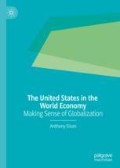Abstract
This chapter examines the benefits and costs of immigration and the key developments in the steady rise of migratory flows to the United States since the mid-1960s. Discussion is focused on the economic impact of these flows on the employment and wage levels of native workers, as regards the migration of both low-skilled and high-skilled workers, and their fiscal impact. The chapter also deals specifically with the causes and effects of illegal immigration in the United States and the policy options that can be considered to reduce its incidence.
Access this chapter
Tax calculation will be finalised at checkout
Purchases are for personal use only
Notes
- 1.
These estimates have been drawn from Clemens (2011).
- 2.
The most recent data on global migration trends can be found in World Migration Reports of the International Organization for Migration and on the website of the Migration Policy Institute (www.migrationpolicy.org), in particular for the United States.
- 3.
For a comparison of immigration patterns across OECD countries, see Hanson and Macintosh (2016).
- 4.
The data on illegal immigrants in the United States are drawn from a comprehensive study of the National Academy of Sciences (NAS) edited by Blau and Mackie (2016).
- 5.
The data on the distribution of migrant workers by level of education can be found in Peri (2013).
- 6.
The data on the allocation of visas for family and work-related reasons are drawn from Orrenius (2012).
- 7.
These results are reported and discussed in Peri (2017).
- 8.
The data on prize winnings and faculty positions held by immigrants in the United States are drawn from Hanson and Slaughter (2013).
- 9.
These results were cited in Orrenius (2012).
- 10.
These estimates of the “immigration surplus” are drawn from Orrenius (2016).
- 11.
These results were cited in Orrenius (2012).
- 12.
These various aspects of the fiscal impact of immigration have been examined in detail in Blau and Mackie (2016).
- 13.
This aspect of the work by the NAS study is analyzed by one of the experts participating in the study, Professor George Borjas of Harvard University, in a separate commentary, “A Users’ Guide to the 2016 National Academy Report on the ‘Economic and Fiscal Consequences of Immigration’”, which appears in Blau and Mackie (2016).
- 14.
This number for illegal immigrants is a widely accepted estimate, but it should be noted that other estimates indicate that the correct number could be 50–100 percent higher; see, for example, Fazel-Zerandi et al. (2018).
- 15.
The factors behind the great wave of Mexican emigration to the United States are examined in more detail in Hanson and Macintosh (2010). These issues have been further analyzed by the Mexican Migration Project, a binational research program managed by the University of Guadalajara and Princeton University (mmp.opr.princeton.edu).
- 16.
For an analysis of illegal immigration in the context of US low-skilled labor immigration, see Hanson et al. (2017).
- 17.
These estimates have been generated by the Mexican Migration Project, cited in note 15. A recent report on the smuggling costs for the four stages of an illegal migrant worker’s crossing from Mexico into Texas across the southern states to farm work in Florida was presented in the Washington Post of June 24, 2018. Also, recent smuggling fees for illegal migrants from Mexico have increased to as much as US$12,000 per person, according to a report in the New York Times of July 1, 2018.
- 18.
These estimates have been drawn from Hanson (2010).
- 19.
The relationship between the issue of work-related visas and illegal immigration is discussed in Clemons and Gough (2018).
References
Blau, Francine, and Christopher Mackie. 2016. The Economic and Fiscal Consequences of Immigration. New York: National Academies Press.
Clemens, Michael. 2011. Economics and Emigration: Trillion-Dollar Bills on the Sidewalk? Journal of Economic Perspectives 25 (3 Summer): 83–106.
Clemons, Michael, and Kate Gough. 2018. Can Regular Migration Channels Reduce Irregular Migration? Center for Global Development Briefing Note (February 2018).
Fazel-Zerandi, Mohammod, et al. 2018. The Number of Undocumented Immigrants in the United States: Estimates Based on Demographic Modelling with Data from 1990 to 2016. Yale School of Management Research Article (September 21, 2018).
Hanson, Gordon. 2010. Regulating Low-Skilled Immigration in the United States. Washington, DC: American Enterprise Press.
Hanson, Gordon, and Craig Macintosh. 2010. The Great Mexican Emigration. Review of Economics and Statistics 92 (4): 798–810.
———. 2016. Is the Mediterranean the New Rio Grande? US and EU Immigration Pressures in the Long Run. Journal of Economic Perspectives 30 (4): 57–82.
Hanson, Gordon, and Matthew Slaughter. 2013. Talent, Immigration and US Economic Competitiveness. A Study Sponsored and Published by the Compete America Coalition (May 2013).
Hanson, Gordon, et al. 2017. The Rise and Fall of US Low-Skilled Immigration. Brookings Papers on Economic Activity (Spring 2017): 83–168.
Orrenius, Pia. 2012. US Immigration: Economic Effects and Policy Implications, German Marshall Fund Policy Brief (January 2012).
———. 2016. The Benefits of Immigration Outweigh the Costs. The Catalyst (A Journal of Ideas from the George W. Bush Institute), Spring (Issue 2).
Peri, Giovanni. 2013. The Economic Benefits of Immigration. UC Berkeley Review of Latin American Studies (Fall 2013): 14–19.
———. 2017. The Impact of Immigration on the Wages of Unskilled Workers. Cato Journal 37 (3): 449–460.
Author information
Authors and Affiliations
Rights and permissions
Copyright information
© 2019 The Author(s)
About this chapter
Cite this chapter
Elson, A. (2019). The United States as a Major Destination for Migratory Flows. In: The United States in the World Economy. Palgrave Macmillan, Cham. https://doi.org/10.1007/978-3-030-20688-8_5
Download citation
DOI: https://doi.org/10.1007/978-3-030-20688-8_5
Published:
Publisher Name: Palgrave Macmillan, Cham
Print ISBN: 978-3-030-20687-1
Online ISBN: 978-3-030-20688-8
eBook Packages: Economics and FinanceEconomics and Finance (R0)

